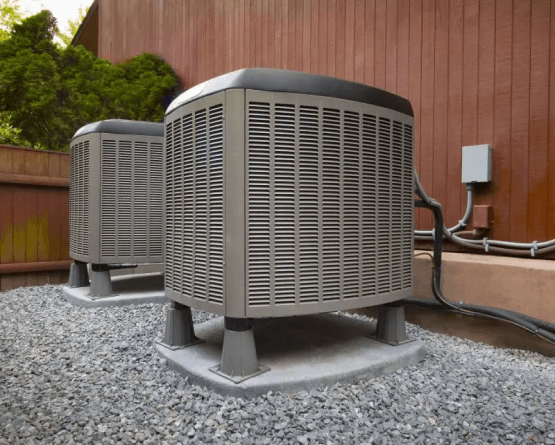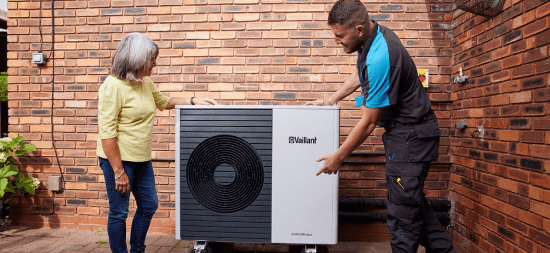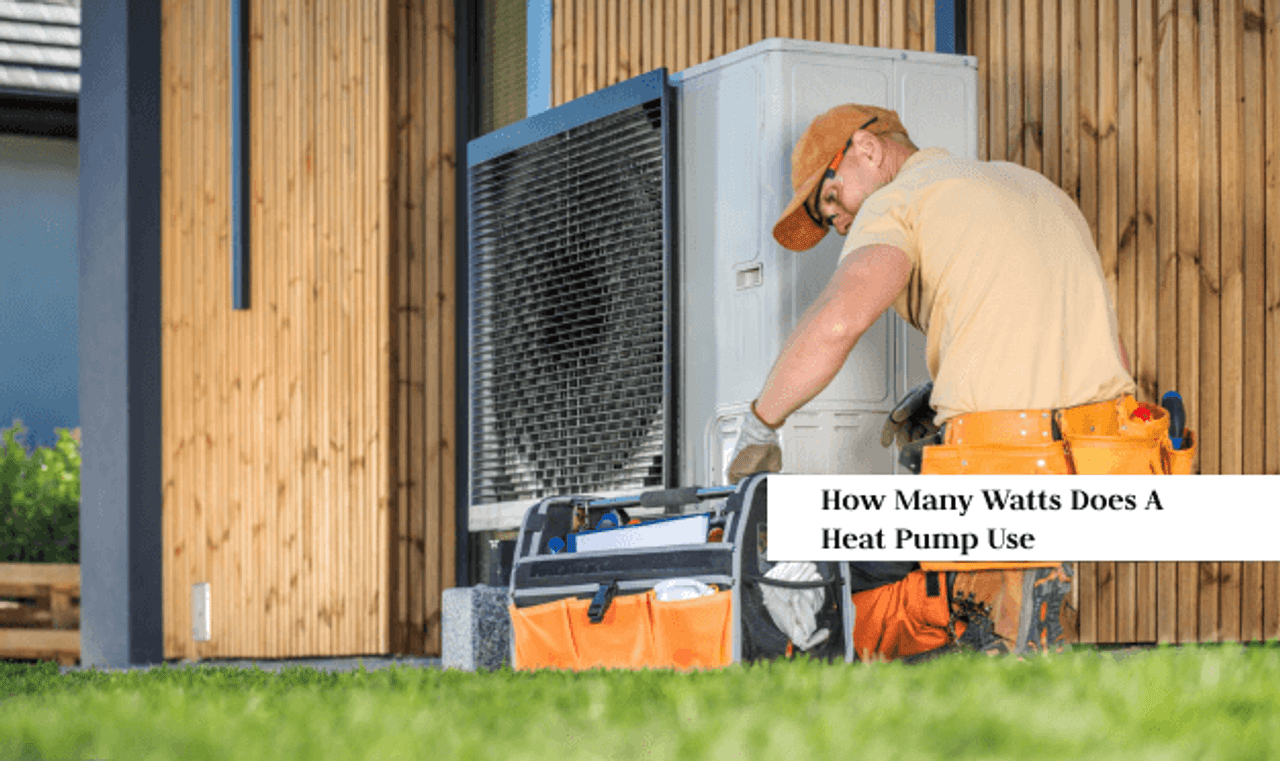How Many Watts Does a Heat Pump Use
A heat pump is an energy-efficient device that transfers heat to regulate indoor temperatures, keeping your home cozy in winter and cool in summer. But have you ever wondered how many watts does a heat pump use during operation? The most popular heat pump in the average home on the US market is the 3-ton cold-climate heat pump, which consumes between 830 W and 6.9 kW. The final calculation depends on several factors, including weather and insulation.
In this article, we’ll break down what affects heat pump energy use, typical wattage ranges, and tips to help you save on power bills. Whether you’re new to heat pumps or just curious, we’ll help you figure it all out!
Key Takeaways
- A heat pump works by transferring heat between outdoors and indoors, with typical residential units consuming between 3,500-7,000 watts of electricity during operation.
- Heat pumps operate with a Coefficient of Performance (COP) ranging from 2.5 to 5.0, meaning they can produce 2.5-5.0 units of heat energy for every unit of electrical energy consumed.
- The actual power consumption of a heat pump is influenced by multiple factors including temperature, building insulation, and system maintenance condition.
- Operating a heat pump typically costs between $50-150 per month at average U.S. electricity rates ($0.14/kWh), depending on usage duration and local climate conditions.
What Is A Heat Pump

A heat pump is an energy-efficient HVAC system that transfers heat between indoor and outdoor spaces, providing both heating and cooling for homes and buildings.
The system works by circulating refrigerant through a cycle of evaporation and condensation. During heating mode, it extracts heat from the outside air (even in cold weather) and moves it indoors; in cooling mode, it removes heat from inside your home and releases it outdoors - similar to how a refrigerator operates.
Common Types and Their Power Consumption:
- Air-source heat pumps (most common): 3,500-7,000 watts during operation
- Ground-source (geothermal) heat pumps: 1,500-5,000 watts
- Ductless mini-split heat pumps: 1,200-4,000 watts per indoor unit
- Hybrid heat pumps: 4,000-8,000 watts in heat pump mode
How Many Watts Does a Heat Pump Use
While a typical residential heat pump uses between 3,500 to 7,000 watts during operation, the actual power consumption can vary dramatically based on numerous factors. To understand your heat pump's specific power usage, it's essential to consider the key factors that influence its energy consumption:
Temperature: Outside temperature has the most substantial impact on heat pump efficiency. In extreme temperatures (below 30°F or above 95°F), heat pumps work harder and consume more power - up to 7,000 watts. During moderate temperatures, power usage can drop to 3,000-4,000 watts.
Home size: Bigger homes generally use more energy for heating and cooling.
Home Insulation: Poor home insulation can increase power consumption by 25-40% as the system needs to run longer and more frequently to compensate for heat loss or gain.
Thermostat Settings: Every degree of difference between indoor and outdoor temperatures affects power usage. Setting your thermostat closer to the outside temperature can reduce power consumption by 5-10% per degree of adjustment.
Heat Pump Size: An appropriately sized heat pump typically uses 600-1,000 watts per ton of capacity. Oversized units consume more power through frequent cycling, while undersized units strain to meet demand, running constantly at high power.
SEER Rating: Higher SEER (Seasonal Energy Efficiency Ratio) ratings indicate better efficiency. A 16 SEER heat pump uses approximately 30% less electricity than a 13 SEER unit for the same cooling output.
System Age: As heat pumps age, they become less efficient. A 10-year-old system might consume 10-20% more power than when new, while a 15+ year old unit could use up to 40% more electricity to provide the same heating/cooling output.
The easiest way to figure out the power draw is to divide the size of the heat pump (measured in BTU), by the heat pump’s efficiency ratings.
Cooling wattage = BTU / SEER
Heating wattage = BTU / HSPF
SEER measures cooling efficiency - higher numbers mean better efficiency
HSPF (Heating Seasonal Performance Factor) measures heating efficiency - higher numbers mean better efficiency
Modern heat pumps typically have SEER ratings between 14-20 and HSPF ratings between 8.2-11
Heat Pump Wattage in Cooling Mode
| Heat Pump Size | Wattage(14 SEER) | Wattage(16 SEER) | Wattage(18 SEER) | Wattage(20 SEER) |
| 1 ton(12000 BTU) | 850W | 750W | 667W | 600W |
| 2 ton(24000 BTU) | 1700W | 1500W | 1350W | 1200W |
| 3 ton(48000 BTU) | 2600W | 2250W | 2000W | 1800W |
| 4 ton(48000 BTU) | 3400W | 3000W | 2650W | 2400W |
| 5 ton(60000 BTU) | 4300W | 3750W | 3300W | 3000W |
Heat Pump Wattage in Heating Mode (at 47°F)
| Heat Pump Size | Wattage(8.2 HSPF) | Wattage(9.0 HSPF) | Wattage(10.0 HSPF) | Wattage(11.0 HSPF) |
| 1 ton(12000 BTU) | 1500W | 1333W | 1200W | 1091W |
| 2 ton(24000 BTU) | 2000W | 1800W | 1600W | 1450W |
| 3 ton(48000 BTU) | 3000W | 2700W | 2400W | 1200W |
| 4 ton(48000 BTU) | 4000W | 3600W | 3200W | 2900W |
| 5 ton(60000 BTU) | 5000W | 4500W | 4000W | 3600W |
Please note that these calculations represent usage under optimal conditions. Actual power consumption and costs may vary based on the factors discussed earlier, such as weather conditions, home insulation, and system maintenance.
How Much Will It Cost to Run A Heat Pump?

Want to calculate your specific costs? Use this simple formula:
Annual Cost = (Wattage × Running Hours × Electricity Rate) ÷ 1000
However, the operating cost of a heat pump varies based on size, efficiency, and usage patterns. Here's a comprehensive breakdown of estimated yearly costs under typical usage patterns based on year-round operation ,2500 running hours per year and the average U.S. electricity rates ($0.14/kWh):
Annual Heat Pump Running Costs
| Heat Pump Size | Low Efficiency(SEER 14/HSPF 8.2) | Medium Efficiency(SEER 16/HSPF 9.0) | High Efficiency(SEER 18/HSPF 10.0) | Premium Efficiency(SEER 20/HSPF 11.0) |
| 1 ton | $500-600/year | $450-500/year | $400-450/year | $350-400/year |
| 2 ton | $950-1100/year | $850-950/year | $750-850/year | $650-750/year |
| 3 ton | $1400-1600/year | $1200-1400/year | $1000-1200/year | $900-1000/year |
| 4 ton | $1800-2000/year | $1600-1800/year | $1400-1600/year | $1200-1400/year |
| 5 ton | $2200-2500/year | $2000-2200/year | $1700-1900/year | $1500-1700/year |
Annual Heat Pump Operating Costs by Climate Zone (3-Ton, SEER 16 Heat Pump)
|
Climate Zone |
Representative City |
Avg. Electricity Rate |
Average Wattage (Cooling/Heating) |
Annual Operating Cost |
|
1A |
Miami |
$0.13/kWh |
2250W/2400W |
$1,820/year |
|
2A |
Houston |
$0.12/kWh |
2250W/2500W |
$1,680/year |
|
2B |
Phoenix |
$0.14/kWh |
2400W/2300W |
$1,960/year |
|
3A |
Atlanta |
$0.12/kWh |
2200W/2600W |
$1,440/year |
|
3B |
Las Vegas |
$0.13/kWh |
2300W/2400W |
$1,560/year |
|
3C |
San Francisco |
$0.26/kWh |
2000W/2500W |
$2,080/year |
|
4A |
New York City |
$0.21/kWh |
2200W/2700W |
$2,520/year |
|
4C |
Seattle |
$0.11/kWh |
2000W/2600W |
$1,100/year |
|
5A |
Chicago |
$0.15/kWh |
2200W/2800W |
$1,950/year |
|
5B |
Denver |
$0.14/kWh |
2200W/2700W |
$1,680/year |
|
6A |
Minneapolis |
$0.14/kWh |
2200W/3000W |
$2,100/year |
|
7A |
Anchorage |
$0.23/kWh |
2000W/3200W |
$2,990/year |
Climate zones in the United States are categorized by the Department of Energy based on temperature patterns and humidity levels. The numbering system (1-7) represents temperature variations from hottest (1) to coldest (7), while the letters indicate humidity levels: 'A' for moist/humid regions, 'B' for dry regions, and 'C' for marine areas. For example, Miami (1A) represents a hot-humid climate, while Anchorage (7A) represents a very cold-humid climate. This classification helps determine the most suitable HVAC equipment and energy requirements for different regions.
How Long Can Renogy Solar Panel Run A Heat Pump?
Although heat pumps are more energy efficient than traditional heating systems, as high-power appliances they typically consume between 1,000 and 5,000 watts of electricity and still account for a large portion of a household's electricity bill. If you're looking to further reduce your electric bill or find reliable power support for your heat pump in an off-grid scenario, solar panels and storage batteries are the ideal solution.Renogy offers high-efficiency solar panels and lithium-ion batteries that can provide continuous and stable green energy support for your heat pump.
4pcs 320 Watt Monocrystalline Solar Panel
For a typical 3-ton heat pump (SEER 16) to run every day, about 5000Wh of electricity is needed, while Renogy 4pcs 320 Watt Monocrystalline Solar Panel can produce 6,400Wh per day, which is sufficient to meet the heat pump's power needs throughout the day. The solar panels utilize highly efficient PERC technology, which not only provides excellent power generation, but also maintains stable performance in high snow and wind conditions, making them suitable for use in all seasons. Whether it's heating in the winter or cooling in the summer, this solar panel allows the heat pump to run efficiently, helping you to get off the grid while significantly reducing your electricity bill.
Core Mini - 12.8V 300Ah Lithium Iron Phosphate Battery
At night or on cloudy days, Renogy Core Mini - 12.8V 300Ah Lithium Iron Phosphate Battery is the ideal backup power source thanks to its 3,840Wh storage capacity. This lithium battery is lighter in weight and has a longer life than traditional lead-acid batteries, and is equipped with low-temperature cut-off protection to ensure safe use in cold weather. Combined with solar panels, you can provide stable power support for your heat pump even when completely off-grid, ideal for high load or power outage scenarios in winter.
| Renogy Products | Running Hours (SEER 14) | Running Hours(SEER 16) |
Running Hours(SEER 18) |
Running Hours(SEER 20) |
|
4pcs 320 Watt Monocrystalline Solar Panel |
2.46 | 2.82 | 3.20 | 3.56 |
|
Core Mini - 12.8V 300Ah Lithium Iron Phosphate Battery |
1.48 | 1.71 | 1.92 | 2.13 |
Rover Lite 60A MPPT Solar Charge Controller
To maximize the efficiency and performance of your solar energy system, a high-quality MPPT solar charge controller is essential. Renogy's Rover Lite 60A MPPT Solar Charge Controller intelligently track the maximum power point of your solar panels, ensuring optimal power transfer and maximizing energy output, even in low-light conditions. By incorporating an MPPT charge controller into your setup, you can further enhance the efficiency and reliability of your solar-powered heat pump system.
Final Thoughts
Understanding how many watts does a heat pump use is the first step in managing your home's energy consumption. By using solar panels and efficient battery storage, you can not only power your heat pump sustainably but also reduce long-term energy costs. Choosing Renogy's solar panels and lithium batteries provides a green, cost-effective solution to meet your heat pump’s energy needs, ensuring a comfortable living environment.
FAQs About Heat Pumps
1. Do Heat Pumps Use a Lot of Electricity?
Heat pumps are generally more energy-efficient than traditional heating and cooling systems, but they still consume electricity. The amount of energy they use depends on factors like the size of the unit, the climate, and how often it's running.
2. How Much Power Does a 12000 BTU Heat Pump Use?
A 12,000 BTU heat pump typically uses between 1,000 to 1,500 watts of power per hour, depending on its efficiency and the operating conditions. This is roughly equivalent to the power consumption of a small air conditioner. The actual energy usage may vary based on factors such as the heat pump's SEER rating, the temperature difference between the inside and outside of the home, and how often the system is running.











